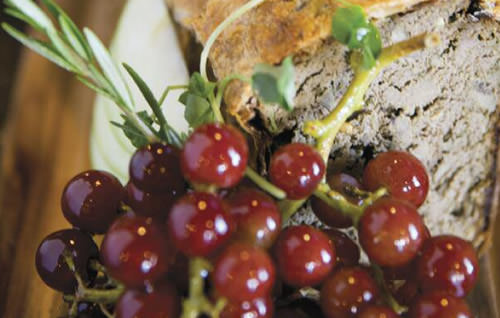edible round-up
THE OFFAL TRUTH
Several local chefs offer rarely used beef cuts on their menus.
WRITTEN BY HEIDI BETHEL
PHOTOS BY JEN BRITTON
For centuries, mankind survived by using every part of the prized animals hunted by the tribe. Today’s chefs are returning to that practice and expanding beyond the typical cuts of meat to include some of those not-so-common bits and pieces. Offal, which is the internal organs, entrails, and other often-discarded parts of an animal, is debuting on the menus of many local eateries.
“In the modern cooking world, it’s becoming common to use the whole animal, from head to tail, and extract the rich, unique flavors,” explains Erick Caballero, executive chef of Brasserie Saint James, in Reno.
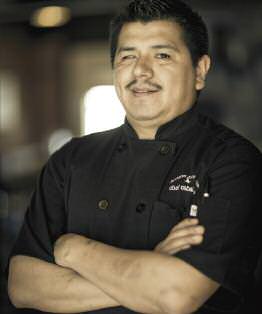
He raves about the interesting textures and many different uses of offal, including sausages and new takes on old favorites such as liver and onions. But perhaps one of Caballero’s favorite dishes of the moment is beef tartare.
“It’s so easy to do,” he says. “Instead of using steak or ground beef, you include the heart along with traditional dressing components. It’s delicious.”
Tongue and Cheek
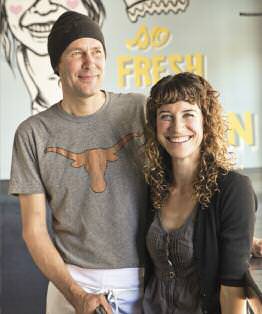
In addition to the internal organs, Larry Dunning, chef/proprietor of Bowl and Rawr restaurants in Reno, enjoys serving delicious meaty dishes in a comical fashion.
“You never see beef tongue and cheek served together,” he says, “and I love both cuts braised. They are some of the best cuts of meat that you can eat. So flavorful, tender, and incredible.”
Dunning recognizes that beef tongue can be a little intimidating.
“The best way to cook it is to braise it and peel the outside layer off,” he says. “Then dice or slice, whichever is preferred, and serve alongside earthy ingredients like truffles, sunchokes, and peas.”
“There are ways of cooking everything,” Caballero adds. “That’s the beauty of working with offal and other cuts; there’s something to be appreciated in transforming it to an outstanding dish with memorable flavor profiles and textures.”
Long ago, Heidi Bethel was a member of Future Farmers of America at Elko High School, where she remembers learning about the different cuts of beef. She appreciates the efforts to use all parts of the animal in extraordinary ways.
Tongue & Cheek
With sunchoke mash, vegetables, and bull’s blood microgreens
(courtesy of Larry Dunning, Bowl and Rawr restaurants, in Reno. Serves 4)
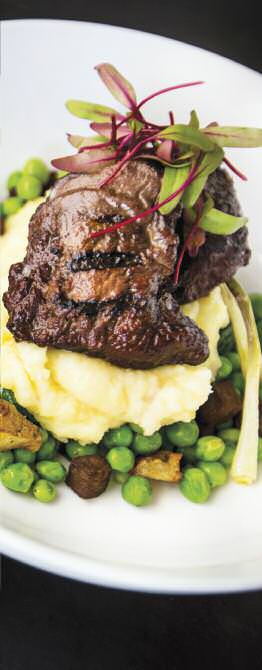
1 beef tongue, soaked and drained
8 beef cheeks
Cooking oil
1 onion, diced
1 carrot, diced
1 celery rib, diced
2 cups red wine
Preheat oven to 250 degrees F. Pat the tongue dry with paper towels. Grill cheeks and tongue, browning on all sides. Heat oil in a heavy-bottomed, ovenproof braising pan or Dutch oven over high heat. Sauté mirepoix (onion, carrot, celery) until soft or golden brown. Add red wine, then the meat. Cover with water or stock and bring to a simmer. Transfer to oven, covered, and braise for 3 hours. Reserve in liquid (except for 2 cups). Pull 2 cups of braising liquid and reduce to ½ cup over medium heat for sauce.
Sunchoke Mash
6 sunchokes
3 red potatoes
1 garlic clove, roasted
1 tablespoon kosher salt
2 tablespoons unsalted butter
⅓ cup milk or heavy cream
Salt and pepper, to taste
Peel sunchokes and potatoes. Cut vegetables into large chunks and place in a pot filled with cold water. Add salt. Cover pot and place on high heat. Bring to boil and simmer for 10 minutes or until tender. Drain. Add butter, cream, and roasted garlic. Mash in high-speed blender or food processor to desired consistency. Season with salt and pepper.
Vegetable-Tongue Sauté
6 sunchokes, diced
½ tongue, diced
1½ cups peas
½ cup leeks, diced
1 truffle
Roast sunchokes in oven until tender at 350 degrees F for 15 – 20 minutes, then set aside. Peel outside layer off of braised beef tongue and dice. Sauté tongue, leeks, sunchokes, and peas.
To assemble dish
Spoon vegetable-tongue sauté onto plate. Spoon sunchoke mash on top of vegetable-tongue sauté in center. Top with two reserved beef cheeks. Spoon sauce over cheeks and lightly microplane truffle over dish. Top with bull’s blood microgreens.
Beef Tartare
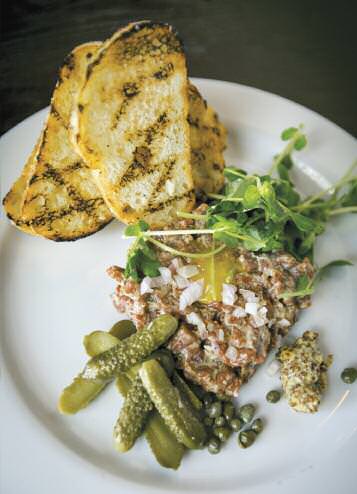
(courtesy of Erick Caballero, Brasserie Saint James, in Reno. Serves 1)
2 egg yolks
2 tablespoons lemon juice
¼ cup Dijon mustard
8 anchovies, minced
1½ tablespoons ketchup
2 teaspoons Worcestershire sauce
½ teaspoon Tabasco sauce
Fresh black pepper, to taste
1/5 cup canola oil
¼ cup rye whiskey
4 ounces cornichons, minced
4 ounces capers, minced
¼ cup parsley, chopped
¼ cup shallots, finely chopped
3 ounces beef heart
Arugula
4 pieces rye toast
Combine egg yolk, lemon juice, Dijon mustard, and anchovies, and whisk together. Add ketchup, Worcestershire sauce, Tabasco sauce, and pepper. Mix well. Add rye whiskey and remaining ingredients. Keep cold.
Finely mince beef heart and add 1 ounce of dressing mixture and a generous pinch of salt, and mix well. Form into disk and garnish with arugula dressed with lemon juice and triangles of rye toast.
Offal resources
Rawr and Bowl restaurants
148 West St., Reno
http://www.Thatbowlrestaurant.com 775-327-4443, http://www.Therawrbar.com 775-327-4448
Brasserie Saint James
901 S. Center St., Reno
http://www.Brasseriesaintjames.com 775-348-8888
JT Basque, in Gardnerville
http://www.Jtbasquenv.com
Louis’ Basque Corner, in Reno
http://www.Louisbasquecorner.com
Beaujolais Bistro, in Reno
http://www.Beaujolaisbistro.com
Campo, in Reno
http://www.Camporeno.com
Heritage, in Reno
http://www.Whitneypeakhotel.com/en-us/heritage/heritage.htm
